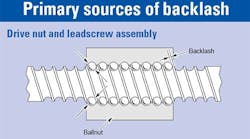Leadscrews, gears, couplings, and other mechanical power transmission devices usually consist of several parts.
When assembled, each part has a certain amount of room or clearance.
As long as a drive train keeps moving in a given direction, the clearances between mating parts have no apparent effect.
But if the drive changes direction, many of the elements must travel through a “dead band” or “dead space” until they make contact with opposite mating surfaces. This dead space or “play” is known as backlash.
In most mechanical systems, some degree of backlash is necessary to reduce friction and wear. A leadscrew and nut assembly, for example, may have between 0.006 and 0.008 in. of backlash.
Q: How can I reduce backlash?
A: Try to approach critical positions from the same direction; or when accelerating, apply a constant torque or force.
It’s also possible to program out backlash by specifying small incremental moves (enough to take out backlash) prior to making a move that counts.
Q: What else can I do?
A: If you’re using a leadscrew, find one with a preloaded nut or an active cam mechanism; or use a precision ground screw.
Q: Does configuration play a role?
A: Yes. Actuators where the motor directly couples to the leadscrew tend to have less backlash than parallel or reverse parallel arrangements based on gear trains or belt drives.
For ballscrews, backlash generally remains constant for life; for acme screws, it usually increases with wear.
